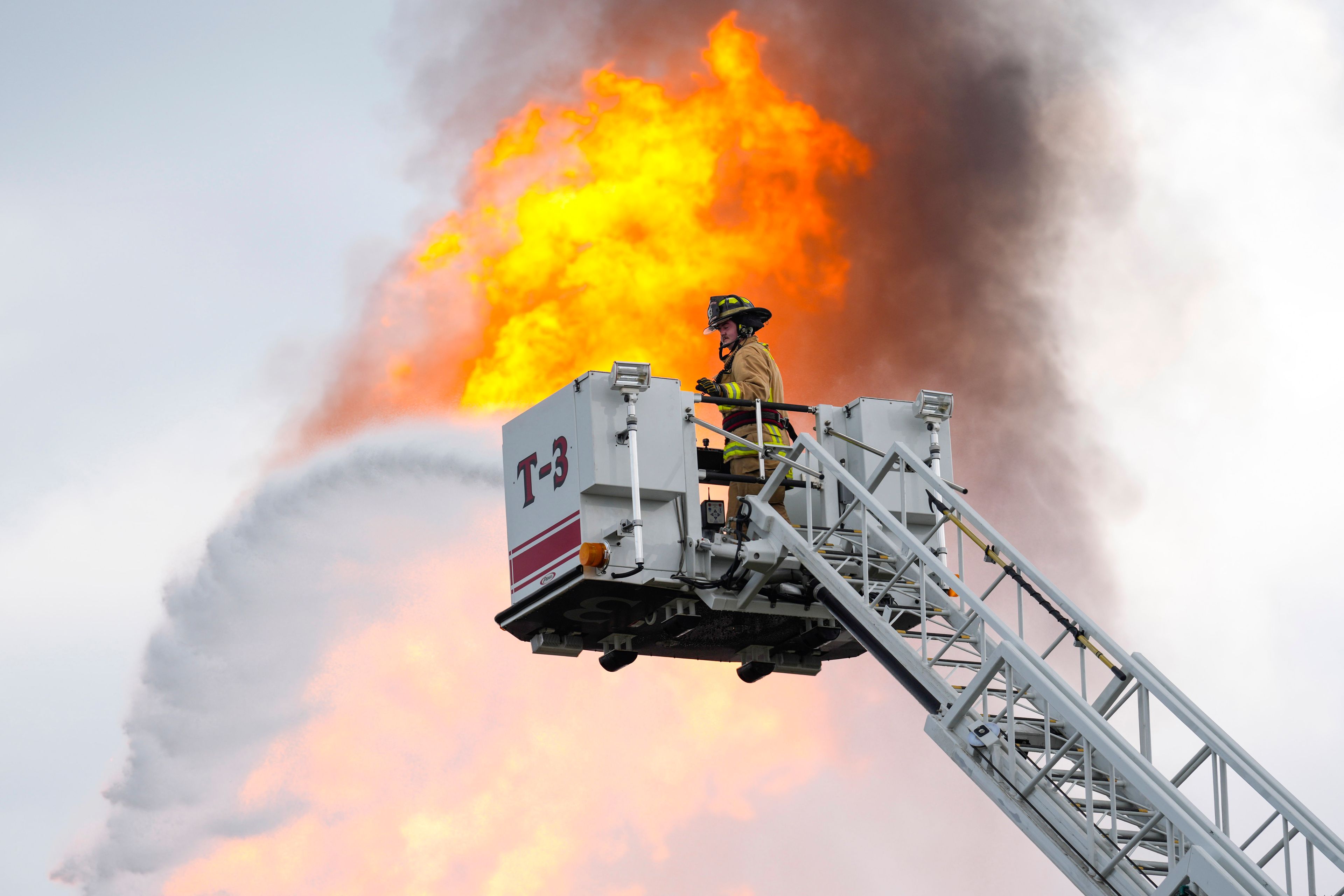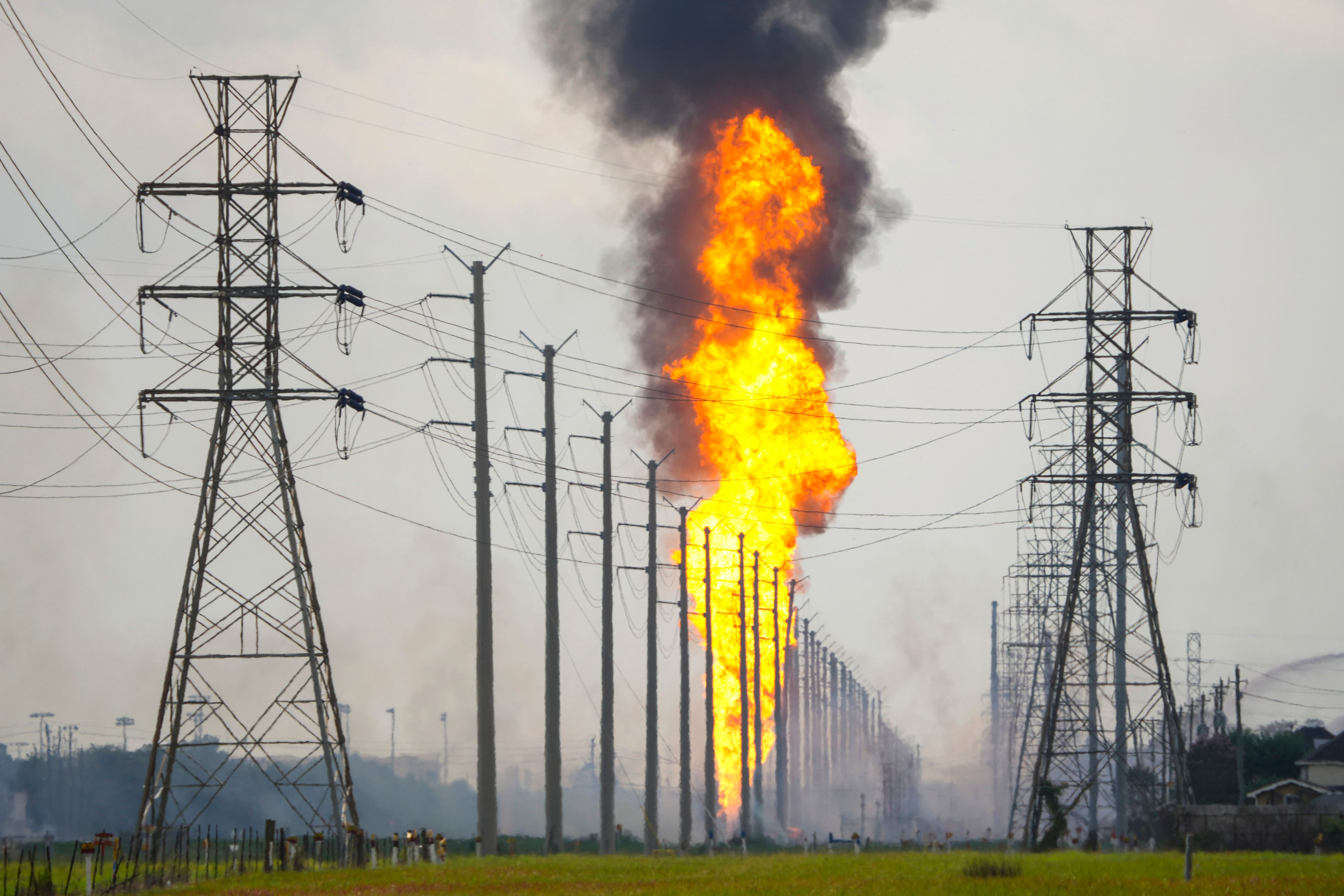Massive pipeline fire burning near Houston began after vehicle struck valve, officials say
DEER PARK, Texas — A massive pipeline explosion that sent a towering flame over neighborhoods near Houston for hours on Monday began after a vehicle drove through a fence and struck an above-ground valve, officials said.
DEER PARK, Texas — A massive pipeline explosion that sent a towering flame over neighborhoods near Houston for hours on Monday began after a vehicle drove through a fence and struck an above-ground valve, officials said.
Deer Park officials said police and local FBI agents found no evidence of “terroristic activity" and said it appears to be an isolated incident. The ongoing investigation includes an effort to identify the driver. The blaze forced evacuations and shelter orders in the area, including at schools.
Operators shut off the flow of natural gas liquids in the pipeline, but so much remained in the miles of pipe that firefighters could do nothing but watch and hose down adjacent homes as a towering flame still lit up the night sky after sunset Monday. Deer Park Mayor Jerry Mouton Jr. said the flames might continue into Tuesday morning.
“The fire, it’s very hot, so a lot of the house structures that are adjacent to that are still catching on fire even though we’re putting a lot of water on them,” Mouton said at an afternoon news conference.
Firefighters were dispatched at 9:55 a.m., after an explosion at a valve station in Deer Park and right next to La Porte rattled adjacent homes and businesses, including a Walmart. Deer Park officials said an SUV drove into the valve after going through a fence on the side of the Walmart parking lot.
Nearly 1,000 homes were in the evacuation area, said Lee Woodward, a spokesperson for La Porte.
At the news conference, officials said only one person, a firefighter, sustained a minor injury. Later, Deer Park spokesperson Kaitlyn Bluejacket said four people were injured. She didn’t provide details about the severity of the injuries.
Harris County Judge Lina Hidalgo said in a statement that 20 miles (32 kilometers) of pipeline between the two closed vales must burn off before the fire stops.
Anna Lewis, who was walking into the nearby Walmart when the explosion happened, said it sounded “like a bomb went off.” She said everyone inside was rushed to the back of the store and then taken across the street to a grocery store before being bussed to a community center.
“It scared me,” she said. “You really don’t know what to do when it’s happening.”
Geselle Melina Guerra said she and her boyfriend heard the explosion as they were having breakfast in their mobile home.
“All of a sudden we hear this loud bang and then I see something bright, like orange, coming from our back door that’s outside,” said Guerra, who lives within the evacuation area.
Guerra’s boyfriend, Jairo Sanchez, said they’re used to evacuations because they live close to other plants near the highway, but he hadn’t seen an explosion before in his 10 years living there.
“We just drove as far as we could because we didn’t know what was happening,” Sanchez said.
Houston, Texas’ largest city, is the nation’s petrochemical heartland and is home to a cluster of refineries and plants and thousands of miles of pipelines. Explosions and fires are a familiar sight in the area, including some that have been deadly, raising recurring questions about the adequacy of industry efforts to protect the public and the environment.
Letting the fire burn out is better, from an environmental perspective, than trying to attack the flames with some kind of suppressing foam or liquid, said Ramanan Krishnamoorti, a petroleum engineering professor at the University of Houston.
“Otherwise it’s going to release a lot of volatile organics into the environment,” he said.
Still, there will undoubtedly be negative environmental consequences, including a release of soot, carbons and organic material, he said.
The pipeline’s owner, Dallas-based Energy Transfer, said air monitoring equipment was being set up near the plume of fire and smoke, which could be seen from at least 10 miles (16 kilometers) away at one point.
A statement from Harris County Pollution Control on Monday afternoon said no volatile organic compounds had been detected. The statement said particulate matter from the smoke was moderate and not an immediate risk to healthy people, although “sensitive populations may want to take precautions.” The Texas Commission on Environmental Quality said it was also monitoring the air.
Natural gas liquids are used primarily in the manufacturing of plastics and basic and intermediate chemicals, Krishnamoorti said.
The fire burned through nearby power lines, and the website PowerOutage.us said several thousand customers were without power at one point in Harris County.
In addition to damage closest to the flame, the area’s extensive pipeline infrastructure will also have to be closely inspected and monitored for damage, Krishnamoorti said.
He said that “in the grand scheme of things,” the fire “won’t be a major disrupter of supply chains.”
The Railroad Commission of Texas, which regulates oil and gas in the state, said its safety inspectors were investigating. The agency said they were receiving information from other pipeline operators about what they were doing to ensure the safety of their systems.
Margaret Newman, who lives on the edge of the evacuation zone, said that when she heard the explosion she went out into her yard and could see the flame shooting above the trees. She lost electricity but has a generator that will keep one of the rooms in her home cool, so she planned to stay.
Newman said that in general, she’s not bothered by living so close to such industry. She said she thought the flame was getting smaller by Monday afternoon.
“I keep waiting for it to go out, poof!” she said. “I’m tired of this.”
___
AP writers Christopher L. Keller in Albuquerque, New Mexico, Valerie Gonzalez in McAllen, Texas, Sean Murphy in Oklahoma City and Jamie Stengle in Dallas contributed to this report.
Connect with the Southeast Missourian Newsroom:
For corrections to this story or other insights for the editor, click here. To submit a letter to the editor, click here. To learn about the Southeast Missourian’s AI Policy, click here.
































